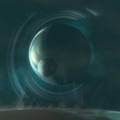Natural satellite: Difference between revisions
From Halopedia, the Halo wiki
mNo edit summary |
Stryker117 (talk | contribs) m (→Gallery: spelling) |
||
| Line 32: | Line 32: | ||
==Gallery== | ==Gallery== | ||
<gallery> | <gallery> | ||
File:HaloReach - ReachMoons.png|Csodaszarvas and | File:HaloReach - ReachMoons.png|Csodaszarvas and Turul, the two natural satellites of [[Reach]]. | ||
File:Ganymede.jpg|Ganymede, one of [[Jupiter]]'s moons. | File:Ganymede.jpg|Ganymede, one of [[Jupiter]]'s moons. | ||
</gallery> | </gallery> | ||
[[Category:Moons| ]] | [[Category:Moons| ]] | ||
[[Category:Astronomical objects]] | [[Category:Astronomical objects]] | ||
Revision as of 15:25, September 18, 2010
Template:Ratings Template:SeeWikipedia
A natural satellite, more commonly referred to as a moon, is a celestial body that orbits a planet or smaller body, which is called the primary.
The large gas giants of Sol have extensive systems of moons, including half a dozen comparable in size to Earth's moon: the four Galilean moons, Saturn's Titan, and Neptune's Triton. Saturn has an additional six mid-sized moons massive enough to have achieved hydrostatic equilibrium, and Uranus has five. Jupiter has more than sixty moons, of which only four are colonized. Those moons are called Jovian Moons. Of the inner planets, Mercury and Venus have no moons at all; Earth has one large moon, Luna, and Mars has two tiny moons, Phobos and Deimos.
Moons in the Halo Universe
- Basis
- Buwan
- Csodaszarvas
- Eayn
- Ehilend
- Jovian Moons
- Luna
- Padpad
- Qikost
- Rantu
- Solrapt
- Suban
- Teash
- Turul
- Uhtua, and 24 unnamed satellites orbiting Te.
- Unnamed Moon
- Warial

